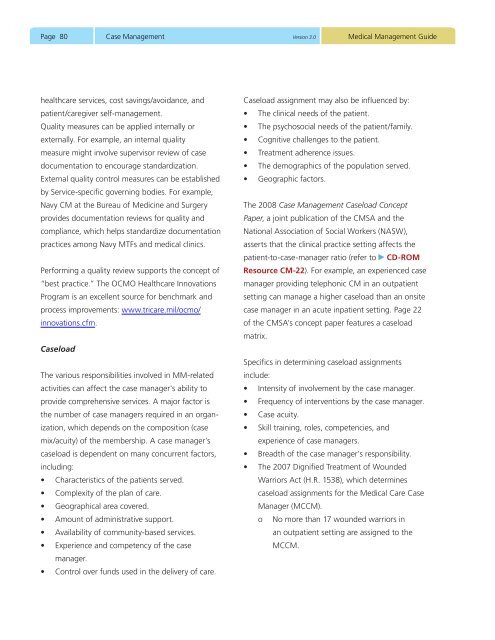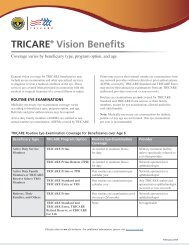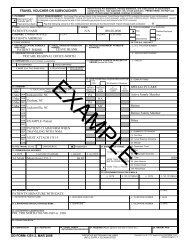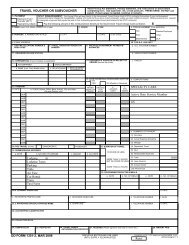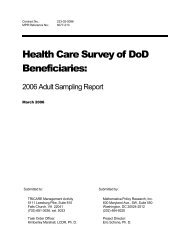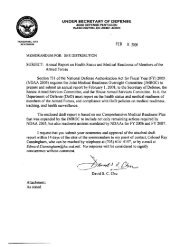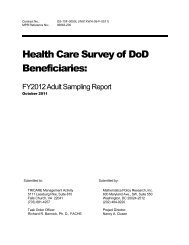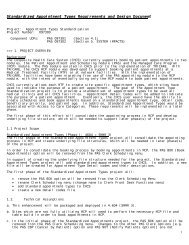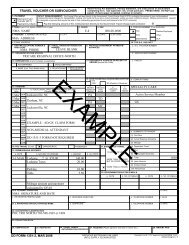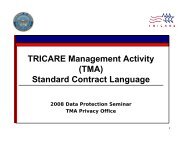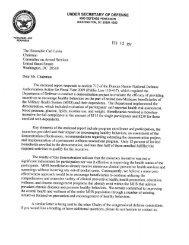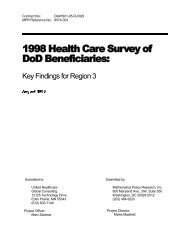Medical Management Guide, 2009, Version 3.0 - Tricare
Medical Management Guide, 2009, Version 3.0 - Tricare
Medical Management Guide, 2009, Version 3.0 - Tricare
- No tags were found...
You also want an ePaper? Increase the reach of your titles
YUMPU automatically turns print PDFs into web optimized ePapers that Google loves.
Page 80Case <strong>Management</strong> <strong>Version</strong> <strong>3.0</strong><strong>Medical</strong> <strong>Management</strong> <strong>Guide</strong>healthcare services, cost savings/avoidance, andpatient/caregiver self-management.Quality measures can be applied internally orexternally. For example, an internal qualitymeasure might involve supervisor review of casedocumentation to encourage standardization.External quality control measures can be establishedby Service-specific governing bodies. For example,Navy CM at the Bureau of Medicine and Surgeryprovides documentation reviews for quality andcompliance, which helps standardize documentationpractices among Navy MTFs and medical clinics.Performing a quality review supports the concept of“best practice.” The OCMO Healthcare InnovationsProgram is an excellent source for benchmark andprocess improvements: www.tricare.mil/ocmo/innovations.cfm.CaseloadThe various responsibilities involved in MM-relatedactivities can affect the case manager's ability toprovide comprehensive services. A major factor isthe number of case managers required in an organization,which depends on the composition (casemix/acuity) of the membership. A case manager’scaseload is dependent on many concurrent factors,including:• Characteristics of the patients served.• Complexity of the plan of care.• Geographical area covered.• Amount of administrative support.• Availability of community-based services.• Experience and competency of the casemanager.• Control over funds used in the delivery of care.Caseload assignment may also be influenced by:• The clinical needs of the patient.• The psychosocial needs of the patient/family.• Cognitive challenges to the patient.• Treatment adherence issues.• The demographics of the population served.• Geographic factors.The 2008 Case <strong>Management</strong> Caseload ConceptPaper, a joint publication of the CMSA and theNational Association of Social Workers (NASW),asserts that the clinical practice setting affects thepatient-to-case-manager ratio (refer to CD-ROMResource CM-22). For example, an experienced casemanager providing telephonic CM in an outpatientsetting can manage a higher caseload than an onsitecase manager in an acute inpatient setting. Page 22of the CMSA’s concept paper features a caseloadmatrix.Specifics in determining caseload assignmentsinclude:• Intensity of involvement by the case manager.• Frequency of interventions by the case manager.• Case acuity.• Skill training, roles, competencies, andexperience of case managers.• Breadth of the case manager’s responsibility.• The 2007 Dignified Treatment of WoundedWarriors Act (H.R. 1538), which determinescaseload assignments for the <strong>Medical</strong> Care CaseManager (MCCM).o No more than 17 wounded warriors inan outpatient setting are assigned to theMCCM.


